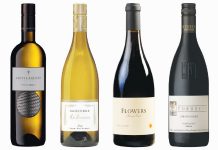A Wine Advice Column by Charles Fredy, Advanced Sommelier
 Sparkling wines are a holiday favorite; their versatility makes them compatible with numerous cuisines. In part, that’s because most are high in acid, and many are blends of white and red grapes. Plus, people love to drink them; the magical fizz enhances friendly food pairings, even when the wine isn’t a perfect match.
Sparkling wines are a holiday favorite; their versatility makes them compatible with numerous cuisines. In part, that’s because most are high in acid, and many are blends of white and red grapes. Plus, people love to drink them; the magical fizz enhances friendly food pairings, even when the wine isn’t a perfect match.
Of course, Champagne is the epitome of sparkling wines, which is why we often reserve it for special occasions. But it’s not your only choice, nor even your only good one. Choosing well begins with understanding how sparkling wines are made.
The most complicated method is the one used for Champagne — in fact, it’s called Methode Champenoise. To simplify a bit: After bottling the base wine, the winemaker adds liqueur de tirage, a mixture of still wine, yeasts and sugar that ignites a second fermentation inside the bottle. This second fermentation, or prise de mousse, is the heart of the Methode Champenoise. Later the yeast is removed — a time-consuming process — but while it’s in the bottle, it contributes to the wine’s flavor profile, complexity and aroma. Trapping the yeast in the bottle also creates bubbles that can’t escape, and that’s what causes the sparkle. As the bubbles are pressurized over time, especially under cold temperatures, they get smaller and more delicate on the palate.
Only wines from the Champagne region of France may use the term Methode Champenoise. Around the world, other wineries use a similar process, but call it Methode Traditionelle or Methode Classique. And they’ll generally note it on the label to indicate the wine’s higher pedigree.
If the sparkling wine you’re thinking of buying doesn’t mention one of those methods, it was probably made from a simpler process known as Charmat (named after the French vintner Eugene Charmat). Instead of in the bottle, the second fermentation happens in a tank. Prosecco is one such wine — though you won’t see “Charmat” on the label, since it refers to a bulk process.
Are Charmat wines ever worth considering? Yes. Not only are they less expensive, they tend to have a lighter, more refreshing style, and many winemakers are creating really good versions. They don’t age as well as classically produced wines, but if you plan to consume them relatively soon, they can be a fine choice.
I suggest you try both styles and see what you like the best.
Here are some of my favorite classical sparkling wines . . .
- Vins El Cep, Marques de Gelida, Brut (Macabeo, Xarel-lo, Parellada, Chardonnay), D.O. Cava, Penedes, Spain, 2009
- Graham Beck, Brut (Chardonnay/Pinot Noir), Cap Classique, South Africa, Non-Vintage
- Grandin, Brut Rose (Cabernet Sauvignon/Cabernet Franc), Vin Mousseux, Loire, France, Non-Vintage and some excellent Charmats . . .
- Secco, Brut Bianco (Glera/Pinot Bianco), Veneto, Italy, 2013
- Adami, Brut Prosecco (Glera), Treviso, Veneto, Italy, Non-Vintage
- Cleto Chiarli, Brut Rose, Spumante (Grasparossa/Pinot Nero), Emilia Romagna, Italy, Non-Vintage
Look for them at Wailea Wine, Tamura’s Fine Wine & Liquors in Kahului and Lahaina Business Park, The Wine Corner in Pa‘ia, R. Field Wine Company at Foodland Farms in Lahaina Gateway, and other retail locations.
Got a wine question? Contact Charles Fredy at facebook.com/ChambersWinesHawaii.





